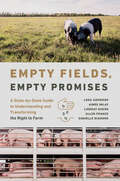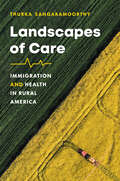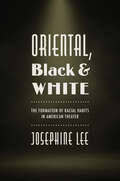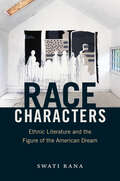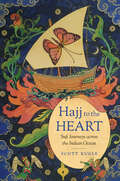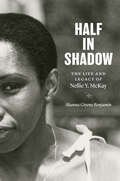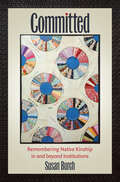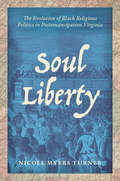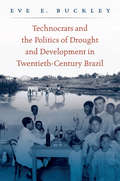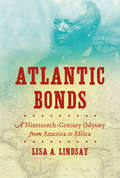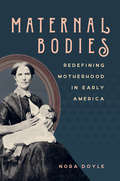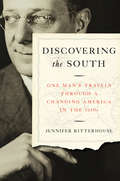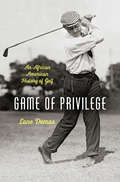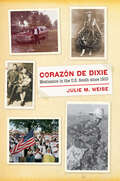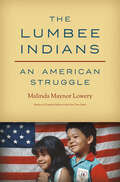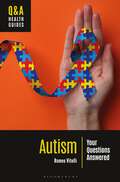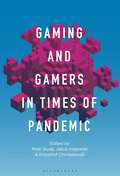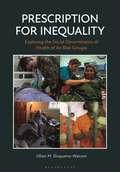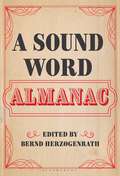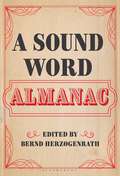- Table View
- List View
Empty Fields, Empty Promises: A State-by-State Guide to Understanding and Transforming the Right to Farm (Rural Studies Series)
by Loka Ashwood Danielle Diamond Allen Franco Aimee Imlay Lindsay KuehnThe right to farm is essential to everyone's survival. Since the late 1970s, states across the nation have adopted so-called right-to-farm laws to limit nuisance suits loosely related to agriculture. But since their adoption, there has yet to be a comprehensive analysis of what these laws do and who they benefit. This book offers the first national analysis and guide to these laws. It reveals that they generally benefit the largest operators, like processing plants, while traditional farmers benefit the least. Disfavored most of all are those seeking to defend their homes and environment against multinational corporations that use right-to-farm laws to strip neighboring owners of their property rights. Through what the book calls the "midburden," right-to-farm laws dispossess the many in favor of the few, paving the path to rural poverty. Empty Fields, Empty Promises summarizes every state's right-to-farm laws to help readers track and navigate their local and regional legal landscape. The book concludes by offering paths forward for a more distributed and democratic agrifood system that achieves agricultural, rural, and environmental justice.
Landscapes of Care: Immigration and Health in Rural America (Studies in Social Medicine)
by Thurka SangaramoorthyThis insightful work on rural health in the United States examines the ways immigrants, mainly from Latin America and the Caribbean, navigate the health care system in the United States. Since 1990, immigration to the United States has risen sharply, and rural areas have seen the highest increases. Thurka Sangaramoorthy reveals that that the corporatization of health care delivery and immigration policies are deeply connected in rural America. Drawing from fieldwork that centers on Maryland's sparsely populated Eastern Shore, Sangaramoorthy shows how longstanding issues of precarity among rural health systems along with the exclusionary logics of immigration have mutually fashioned a "landscape of care" in which shared conditions of physical suffering and emotional anxiety among immigrants and rural residents generate powerful forms of regional vitality and social inclusion. Sangaramoorthy connects the Eastern Shore and its immigrant populations to many other places around the world that are struggling with the challenges of global migration, rural precarity, and health governance. Her extensive ethnographic and policy research shows the personal stories behind health inequity data and helps to give readers a human entry point into the enormous challenges of immigration and rural health.
Oriental, Black, and White: The Formation of Racial Habits in American Theater
by Josephine LeeIn this book, Josephine Lee looks at the intertwined racial representations of nineteenth- and early twentieth-century American theater. In minstrelsy, melodrama, vaudeville, and musicals, both white and African American performers enacted blackface characterizations alongside oriental stereotypes of opulence and deception, comic servitude, and exotic sexuality. Lee shows how blackface types were often associated with working-class masculinity and the development of a nativist white racial identity for European immigrants, while the oriental marked what was culturally coded as foreign, feminized, and ornamental. These conflicting racial connotations were often intermingled in actual stage performance, as stage productions contrasted nostalgic characterizations of plantation slavery with the figures of the despotic sultan, the seductive dancing girl, and the comic Chinese laundryman. African American performers also performed common oriental themes and characterizations, repurposing them for their own commentary on Black racial progress and aspiration. The juxtaposition of orientalism and black figuration became standard fare for American theatergoers at a historical moment in which the color line was rigidly policed. These interlocking cross-racial impersonations offer fascinating insights into habits of racial representation both inside and outside the theater.
Race Characters: Ethnic Literature and the Figure of the American Dream
by Swati RanaA vexed figure inhabits U.S. literature and culture: the visibly racialized immigrant who disavows minority identity and embraces the American dream. Such figures are potent and controversial, for they promise to expiate racial violence and perpetuate an exceptionalist ideal of America. Swati Rana grapples with these figures, building on studies of literary character and racial form. Rana offers a new way to view characterization through racialization that creates a fuller social reading of race. Situated in a nascent period of ethnic identification from 1900 to 1960, this book focuses on immigrant writers who do not fit neatly into a resistance-based model of ethnic literature. Writings by Paule Marshall, Ameen Rihani, Dalip Singh Saund, Jose Garcia Villa, and Jose Antonio Villarreal symbolize different aspects of the American dream, from individualism to imperialism, assimilation to upward mobility. The dynamics of characterization are also those of contestation, Rana argues. Analyzing the interrelation of persona and personhood, Race Characters presents an original method of comparison, revealing how the protagonist of the American dream is socially constrained and structurally driven.
Realizing Islam: The Tijaniyya in North Africa and the Eighteenth-Century Muslim World (Islamic Civilization and Muslim Networks)
by Zachary Valentine WrightThe Tijaniyya is the largest Sufi order in West and North Africa. In this unprecedented analysis of the Tijaniyya's origins and development in the late eighteenth century, Zachary Valentine Wright situates the order within the broader intellectual history of Islam in the early modern period. Introducing the group's founder, Ahmad al-Tijani (1737–1815), Wright focuses on the wider network in which al-Tijani traveled, revealing it to be a veritable global Islamic revival whose scholars commanded large followings, shared key ideas, and produced literature read widely throughout the Muslim world. They were linked through chains of knowledge transmission from which emerged vibrant discourses of renewal in the face of perceived social and political corruption. Wright argues that this constellation of remarkable Muslim intellectuals, despite the uncertainly of the age, promoted personal verification in religious learning. With distinctive concern for the notions of human actualization and a universal human condition, the Tijaniyya emphasized the importance of the realization of Muslim identity. Since its beginnings in North Africa in the eighteenth century, the Tijaniyya has quietly expanded its influence beyond Africa, with significant populations in the Middle East, Southeast Asia, and North America. We are proud to offer this book in our usual print and ebook formats, plus as an open-access edition available through the Sustainable History Monograph Project.
Hajj to the Heart: Sufi Journeys across the Indian Ocean (Islamic Civilization and Muslim Networks)
by Scott KugleAgainst the sweeping backdrop of South Asian history, this is a story of journeys taken by sixteenth-century reformist Muslim scholars and Sufi mystics from India to Arabia. At the center is the influential Sufi scholar Shaykh Ali Muttaqi and his little-known network of disciples. Scott Kugle relates how Ali Muttaqi, an expert in Arabic, scriptural hermeneutics, and hadith, left his native South Asia and traversed treacherous seas to make the Hajj to Mecca. Settling in Mecca, he continued to influence his homeland from overseas. Kugle draws on his original translations of Arabic and Persian manuscripts, never before available in English, to trace Ali Muttaqi's devotional writings, revealing how the Hajj transformed his spiritual life and political loyalties. The story expands across three generations of peripatetic Sufi masters in the Mutaqqi lineage as they travel for purposes of pilgrimage, scholarship, and sometimes simply for survival along Indian Ocean maritime routes linking global Muslim communities. Exploring the political intrigue, scholarly debates, and diverse social milieus that shaped the colorful personalities of his Sufi subjects, Kugle argues for the importance of Indian Sufi thought in the study of hadith and of ethics in Islam. We are proud to announce that this book is freely available in an open-access enhanced edition thanks to TOME (Toward an Open Monograph Ecosystem)—a collaboration of the Association of American Universities, the Association of University Presses, and the Association of Research Libraries—and the generous support of Emory University and the Andrew W. Mellon Foundation. Learn more at the TOME website: openmonographs.org. The open-access enhanced edition of Hajj to the Heart can be found here: https://manifold.ecds.emory.edu/projects/hajj-to-the-heart
Half in Shadow: The Life and Legacy of Nellie Y. McKay
by Shanna Greene BenjaminNellie Y. McKay (1930–2006) was a pivotal figure in contemporary American letters. The author of several books, McKay is best known for coediting the canon-making with Henry Louis Gates Jr., which helped secure a place for the scholarly study of Black writing that had been ignored by white academia. However, there is more to McKay's life and legacy than her literary scholarship. After her passing, new details about McKay's life emerged, surprising everyone who knew her. Why did McKay choose to hide so many details of her past? Shanna Greene Benjamin examines McKay's path through the professoriate to learn about the strategies, sacrifices, and successes of contemporary Black women in the American academy. Benjamin shows that McKay's secrecy was a necessary tactic that a Black, working-class woman had to employ to succeed in the white-dominated space of the American English department. Using extensive archives and personal correspondence, Benjamin brings together McKay’s private life and public work to expand how we think about Black literary history and the place of Black women in American culture.
Committed: Remembering Native Kinship in and beyond Institutions (Critical Indigeneities)
by Susan BurchBetween 1902 and 1934, the United States confined hundreds of adults and children from dozens of Native nations at the Canton Asylum for Insane Indians, a federal psychiatric hospital in South Dakota. But detention at the Indian Asylum, as families experienced it, was not the beginning or end of the story. For them, Canton Asylum was one of many places of imposed removal and confinement, including reservations, boarding schools, orphanages, and prison-hospitals. Despite the long reach of institutionalization for those forcibly held at the Asylum, the tenacity of relationships extended within and beyond institutional walls. In this accessible and innovative work, Susan Burch tells the story of the Indigenous people—families, communities, and nations, across generations to the present day—who have experienced the impact of this history. Drawing on oral history interviews, correspondence, material objects, and archival sources, Burch reframes the histories of institutionalized people and the places that held them. Committed expands the boundaries of Native American history, disability studies, and U.S. social and cultural history generally.
Soul Liberty: The Evolution of Black Religious Politics in Postemancipation Virginia
by Nicole Myers TurnerThat churches are one of the most important cornerstones of black political organization is a commonplace. In this history of African American Protestantism and American politics at the end of the Civil War, Nicole Myers Turner challenges the idea of black churches as having always been politically engaged. Using local archives, church and convention minutes, and innovative Geographic Information Systems (GIS) mapping, Turner reveals how freedpeople in Virginia adapted strategies for pursuing the freedom of their souls to worship as they saw fit—and to participate in society completely in the evolving landscape of emancipation. Freedpeople, for both evangelical and electoral reasons, were well aware of the significance of the physical territory they occupied, and they sought to organize the geographies that they could in favor of their religious and political agendas at the outset of Reconstruction. As emancipation included opportunities to purchase properties, establish black families, and reconfigure gender roles, the ministry became predominantly male, a development that affected not only discourses around family life but also the political project of crafting, defining, and teaching freedom. After freedmen obtained the right to vote, an array of black-controlled institutions increasingly became centers for political organizing on the basis of networks that mirrored those established earlier by church associations. We are proud to announce that this book will also be published as an enhanced open-access e-book on a companion website hosted by Fulcrum, an innovative publishing platform launched by Michigan Publishing at the University of Michigan Library. The Fulcrum version of the book can be located using this link: https://doi.org/10.5149/9781469655253_Turner.
Technocrats and the Politics of Drought and Development in Twentieth-Century Brazil
by Eve E. BuckleyEve E. Buckley’s study of twentieth-century Brazil examines the nation’s hard social realities through the history of science, focusing on the use of technology and engineering as vexed instruments of reform and economic development. Nowhere was the tension between technocratic optimism and entrenched inequality more evident than in the drought-ridden Northeast sertão, plagued by chronic poverty, recurrent famine, and mass migrations. Buckley reveals how the physicians, engineers, agronomists, and mid-level technocrats working for federal agencies to combat drought were pressured by politicians to seek out a technological magic bullet that would both end poverty and obviate the need for land redistribution to redress long-standing injustices.
Atlantic Bonds: A Nineteenth-Century Odyssey from America to Africa (H. Eugene and Lillian Youngs Lehman Series)
by Lisa A. LindsayA decade before the American Civil War, James Churchwill Vaughan (1828–1893) set out to fulfill his formerly enslaved father's dying wish that he should leave America to start a new life in Africa. Over the next forty years, Vaughan was taken captive, fought in African wars, built and rebuilt a livelihood, and led a revolt against white racism, finally becoming a successful merchant and the founder of a wealthy, educated, and politically active family. Tracing Vaughan's journey from South Carolina to Liberia to several parts of Yorubaland (present-day southwestern Nigeria), Lisa Lindsay documents this "free" man's struggle to find economic and political autonomy in an era when freedom was not clear and unhindered anywhere for people of African descent. In a tour de force of historical investigation on two continents, Lindsay tells a story of Vaughan's survival, prosperity, and activism against a seemingly endless series of obstacles. By following Vaughan's transatlantic journeys and comparing his experiences to those of his parents, contemporaries, and descendants in Nigeria and South Carolina, Lindsay reveals the expansive reach of slavery, the ambiguities of freedom, and the surprising ways that Africa, rather than America, offered new opportunities for people of African descent.
Maternal Bodies: Redefining Motherhood in Early America
by Nora DoyleIn the second half of the eighteenth century, motherhood came to be viewed as women's most important social role, and the figure of the good mother was celebrated as a moral force in American society. Nora Doyle shows that depictions of motherhood in American culture began to define the ideal mother by her emotional and spiritual roles rather than by her physical work as a mother. As a result of this new vision, lower-class women and non-white women came to be excluded from the identity of the good mother because American culture defined them in terms of their physical labor. However, Doyle also shows that childbearing women contradicted the ideal of the disembodied mother in their personal accounts and instead perceived motherhood as fundamentally defined by the work of their bodies. Enslaved women were keenly aware that their reproductive bodies carried a literal price, while middle-class and elite white women dwelled on the physical sensations of childbearing and childrearing. Thus motherhood in this period was marked by tension between the lived experience of the maternal body and the increasingly ethereal vision of the ideal mother that permeated American print culture.
Discovering the South: One Man's Travels through a Changing America in the 1930s
by Jennifer RitterhouseDuring the Great Depression, the American South was not merely "the nation's number one economic problem," as President Franklin Roosevelt declared. It was also a battlefield on which forces for and against social change were starting to form. For a white southern liberal like Jonathan Daniels, editor of the Raleigh News and Observer, it was a fascinating moment to explore. Attuned to culture as well as politics, Daniels knew the true South lay somewhere between Erskine Caldwell's Tobacco Road and Margaret Mitchell's Gone with the Wind. On May 5, 1937, he set out to find it, driving thousands of miles in his trusty Plymouth and ultimately interviewing even Mitchell herself. In Discovering the South historian Jennifer Ritterhouse pieces together Daniels's unpublished notes from his tour along with his published writings and a wealth of archival evidence to put this one man's journey through a South in transition into a larger context. Daniels's well chosen itinerary brought him face to face with the full range of political and cultural possibilities in the South of the 1930s, from New Deal liberalism and social planning in the Tennessee Valley Authority, to Communist agitation in the Scottsboro case, to planters' and industrialists' reactionary worldview and repressive violence. The result is a lively narrative of black and white southerners fighting for and against democratic social change at the start of the nation's long civil rights era. For more information on this book, see www.discoveringthesouth.org.
Game of Privilege: An African American History of Golf (The John Hope Franklin Series in African American History and Culture)
by Lane DemasThis groundbreaking history of African Americans and golf explores the role of race, class, and public space in golf course development, the stories of individual black golfers during the age of segregation, the legal battle to integrate public golf courses, and the little-known history of the United Golfers Association (UGA)--a black golf tour that operated from 1925 to 1975. Lane Demas charts how African Americans nationwide organized social campaigns, filed lawsuits, and went to jail in order to desegregate courses; he also provides dramatic stories of golfers who boldly confronted wider segregation more broadly in their local communities. As national civil rights organizations debated golf’s symbolism and whether or not to pursue the game’s integration, black players and caddies took matters into their own hands and helped shape its subculture, while UGA participants forged one of the most durable black sporting organizations in American history as they fought to join the white Professional Golfers’ Association (PGA). From George F. Grant’s invention of the golf tee in 1899 to the dominance of superstar Tiger Woods in the 1990s, this revelatory and comprehensive work challenges stereotypes and indeed the fundamental story of race and golf in American culture.
Corazón de Dixie: Mexicanos in the U.S. South since 1910 (The David J. Weber Series in the New Borderlands History)
by Julie M. WeiseWhen Latino migration to the U.S. South became increasingly visible in the 1990s, observers and advocates grasped for ways to analyze "new" racial dramas in the absence of historical reference points. However, as this book is the first to comprehensively document, Mexicans and Mexican Americans have a long history of migration to the U.S. South. Corazon de Dixie recounts the untold histories of Mexicanos' migrations to New Orleans, Mississippi, Arkansas, Georgia, and North Carolina as far back as 1910. It follows Mexicanos into the heart of Dixie, where they navigated the Jim Crow system, cultivated community in the cotton fields, purposefully appealed for help to the Mexican government, shaped the southern conservative imagination in the wake of the civil rights movement, and embraced their own version of suburban living at the turn of the twenty-first century. Rooted in U.S. and Mexican archival research, oral history interviews, and family photographs, Corazon de Dixie unearths not just the facts of Mexicanos' long-standing presence in the U.S. South but also their own expectations, strategies, and dreams.
The Lumbee Indians: An American Struggle
by Malinda Maynor LoweryJamestown, the Lost Colony of Roanoke, and Plymouth Rock are central to America's mythic origin stories. Then, we are told, the main characters--the "friendly" Native Americans who met the settlers--disappeared. But the history of the Lumbee Tribe of North Carolina demands that we tell a different story. As the largest tribe east of the Mississippi and one of the largest in the country, the Lumbees have survived in their original homelands, maintaining a distinct identity as Indians in a biracial South. In this passionately written, sweeping work of history, Malinda Maynor Lowery narrates the Lumbees' extraordinary story as never before. The Lumbees' journey as a people sheds new light on America's defining moments, from the first encounters with Europeans to the present day. How and why did the Lumbees both fight to establish the United States and resist the encroachments of its government? How have they not just survived, but thrived, through Civil War, Jim Crow, the civil rights movement, and the war on drugs, to ultimately establish their own constitutional government in the twenty-first century? Their fight for full federal acknowledgment continues to this day, while the Lumbee people's struggle for justice and self-determination continues to transform our view of the American experience. Readers of this book will never see Native American history the same way.
Autism: Your Questions Answered (Q&A Health Guides)
by Romeo VitelliResearch suggests that about 1% of the world's population is on the autism spectrum. Discover the answers to common questions about living with neurodiversity.Part of the Q&A Health Guides series, this book offers a broad introduction to autism spectrum disorder (ASD). The book's 47 questions cover what ASD is and its common characteristics, the biological and environmental factors that may lead to ASD, how autism is diagnosed and managed, and how those living with ASD can reach their full potential. Autism: Your Questions Answered addresses these and other topics in a way that both celebrates neurodiversity and acknowledges the many challenges that those with ASD face.Augmenting the main text, a collection of 5 case studies illustrate key concepts and issues through relatable stories and insightful recommendations. The common misconceptions section at the beginning of the volume dispels 5 long-standing and harmful myths about ASD, directing readers to additional information in the text. The glossary defines terms that may be unfamiliar to readers, while the directory of resources curates a list of the most useful books, websites, and other materials. Finally, whether they're looking for more information about this subject or any other health-related topic, readers can turn to the guide to health literacy section for practical tools and strategies for finding, evaluating, and using credible sources of health information both on and off the Internet.
Epidemics and Pandemics: Your Questions Answered (Q&A Health Guides)
by Charles VidichIn the wake of COVID, it's more important than ever to understand epidemics-how they emerge and what we can do to fight back.Part of Bloomsbury's Q&A Health Guides series, this book takes a balanced approach, offering a blend of both epidemiological science and practical suggestions grounded in that science. The volume's 47 questions begin with the basics, including which diseases are most likely to become epidemics, which have historically been the deadliest, and how factors such as climate change will affect the emergence of future pandemics. Next, the book answers readers' questions regarding how epidemics spread and how strategies such as disease reporting, quarantine, and vaccine development can help combat them. Readers will also find questions offering guidance on how to protect yourself during a widespread disease event, including which information sources to trust and how personal choices can influence exposure risk. The final section of questions examines epidemics' far-reaching impacts on everything from mental health to economic prosperity.Augmenting the main text, a collection of 5 case studies illustrate key concepts and issues through relatable stories and insightful recommendations. The common misconceptions section at the beginning of the volume dispels 5 long-standing myths about epidemics and pandemics (the influence of which could be seen throughout the COVID-19 crisis), directing readers to additional information in the text. The glossary defines terms that may be unfamiliar to readers, while the directory of resources curates a list of the most useful books, websites, and other materials. Finally, whether they're looking for more information about this subject or any other health-related topic, readers can turn to the Guide to Health Literacy section for practical tools and strategies for finding, evaluating, and using credible sources of health information both on and off the Internet.
Gaming and Gamers in Times of Pandemic
This edited collection brings in multiple scholarly perspectives to examine the impact of the pandemic and resulting government policies, especially lockdowns, on one particular cultural sphere: games.The COVID-19 pandemic has impacted virtually every aspect of our lives, regardless of where we live. In the initial months, many industry reports noted the unexpected positive impact on online digital game sales. Games were not just lockdown-proof, but boosted by lockdowns. Stay-at-home orders triggered a rush toward games as an alternative form of entertainment, and the ubiquity of mobile phones allowed wider than ever participation. Gaming and Gamers in Times of Pandemic studies how the COVID-19 pandemic affected game players, game developers, game journalists and game scholars alike in many other ways, starting with the most direct – illness, and sometimes death. Some effects are temporary, others are here to stay.
Gaming and Gamers in Times of Pandemic
by Piotr SiudaThis edited collection brings in multiple scholarly perspectives to examine the impact of the pandemic and resulting government policies, especially lockdowns, on one particular cultural sphere: games.The COVID-19 pandemic has impacted virtually every aspect of our lives, regardless of where we live. In the initial months, many industry reports noted the unexpected positive impact on online digital game sales. Games were not just lockdown-proof, but boosted by lockdowns. Stay-at-home orders triggered a rush toward games as an alternative form of entertainment, and the ubiquity of mobile phones allowed wider than ever participation. Gaming and Gamers in Times of Pandemic studies how the COVID-19 pandemic affected game players, game developers, game journalists and game scholars alike in many other ways, starting with the most direct – illness, and sometimes death. Some effects are temporary, others are here to stay.
Prescription for Inequality: Exploring the Social Determinants of Health of At-Risk Groups
by Jillian M. Duquaine-WatsonThis book explores how social determinants of health (SDH) impact the health of a variety of marginalized demographic groups in the United States. Chapters focus on the 13 groups that research demonstrates are most disadvantaged by SDH and, consequently, who suffer the most from ongoing health disparities in America. This includes Black and Hispanic individuals, the LGBTQIA+ community, women, the elderly, people with disabilities, veterans, and those living in rural areas, among others.Chapters follow a standardized format that makes it easy for readers to focus in on aspects of the subject that are of greatest interest. Each profile begins with a snapshot of that group's current state of health, including the biggest medical concerns and how other determinants of health may play a role. Next, each chapter takes an in-depth look at the four components of SDH: economic factors, educational access and quality, healthcare access and quality, and living environment and social context. Unique problems and possible solutions are explored within each of these four sections. An end-of-volume bibliography and further readings list points readers who wish to continue their investigation of the topic toward additional information.Relying on an interdisciplinary framework, the book incorporates research from diverse fields including public health, feminist theory, critical studies of race and ethnicity, poverty studies, disability studies, aging studies, cultural competence, legal studies, and global health. In recognition of the reality that health disparities are the result of a complex interplay of forces and structural factors that permeate American culture, analysis extends beyond health and health care to include a broad range of interrelated social, political, economic, and educational components.
A Sound Word Almanac
This almanac of sound words important to artists and scholars highlights words that expand the way we speak (and write) about sonic experiences.Why write about sound, and how? If sonic philosophy is the attempt "to think about sound by philosophical means," then a metaphilosophical debate appears almost immediately on the horizon: What is called for is an understanding about sound and language, but also about the preconditions of musical understanding. What is at stake is the question of language and sound, as well as expanding how we speak about sonic experience.This almanac tackles these questions from artistic, experimental and personal perspectives. An assemblage of nearly 70 practitioners and theoreticians, artists and scholars offer their favorite 'sound word.' These sound words are onomatopoetical, mythological, practical; words of personal importance to the artists and their craft; words from their memory, related to sound. Many entries are not in English – some are untranslatable – and all are accompanied by a personal, explanatory, poetic entry. These are words that have the potential to change our perspective on listening-musicking-thinking.
A Sound Word Almanac
by Bernd HerzogenrathThis almanac of sound words important to artists and scholars highlights words that expand the way we speak (and write) about sonic experiences.Why write about sound, and how? If sonic philosophy is the attempt "to think about sound by philosophical means," then a metaphilosophical debate appears almost immediately on the horizon: What is called for is an understanding about sound and language, but also about the preconditions of musical understanding. What is at stake is the question of language and sound, as well as expanding how we speak about sonic experience.This almanac tackles these questions from artistic, experimental and personal perspectives. An assemblage of nearly 70 practitioners and theoreticians, artists and scholars offer their favorite 'sound word.' These sound words are onomatopoetical, mythological, practical; words of personal importance to the artists and their craft; words from their memory, related to sound. Many entries are not in English – some are untranslatable – and all are accompanied by a personal, explanatory, poetic entry. These are words that have the potential to change our perspective on listening-musicking-thinking.
Frictionlessness: The Silicon Valley Philosophy of Seamless Technology and the Aesthetic Value of Imperfection (Thinking Media)
by Jakko KemperFrictionlessness provides an examination of the environmentally destructive digital design philosophy of "frictionlessness" and the critical significance of a technological aesthetic of imperfection.If there is one thing that defines digital consumer technologies today, it is that they are designed to feel frictionless. From smart technologies to cloud computing, from from one-click shopping to the promise of seamless streaming-digital technology is framed to host ever-faster operations while receding increasingly into the background of perception. The environmental costs of this fetishization of frictionlessness are enormous and unevenly distributed; the frictionless experience of the end user tends to be supported by opaque networks of exploited labor and extracted resources that disproportionately impact the Global South. This situation marks an urgent need for alternate, less destructive aesthetic relations to technology. As such, this book examines imperfection, as an aesthetic concept that highlights existential conditions of finitude and fragility, as a particularly powerful counterweight to the dominant digital design philosophy of frictionlessness.While frictionlessness aims to draw the user's perception away from the exploitative and destructive conditions of digital production, imperfection forms an aesthetic source of friction that alerts users to the fragile nature of technology and the finite resources on which it relies. These arguments are elaborated through a close reading of three technological objects-a video game that was programmed to expire, an audiovisual performance that laments the fate of disused technology and a collection of music albums that dramatize a techno-cultural logic of relentless consumerism. Together, these case studies underline the value of technological aesthetics of imperfection and point to the need for a renewed ethics of care in relation to technology.
Frictionlessness: The Silicon Valley Philosophy of Seamless Technology and the Aesthetic Value of Imperfection (Thinking Media)
by Jakko KemperFrictionlessness provides an examination of the environmentally destructive digital design philosophy of "frictionlessness" and the critical significance of a technological aesthetic of imperfection.If there is one thing that defines digital consumer technologies today, it is that they are designed to feel frictionless. From smart technologies to cloud computing, from from one-click shopping to the promise of seamless streaming-digital technology is framed to host ever-faster operations while receding increasingly into the background of perception. The environmental costs of this fetishization of frictionlessness are enormous and unevenly distributed; the frictionless experience of the end user tends to be supported by opaque networks of exploited labor and extracted resources that disproportionately impact the Global South. This situation marks an urgent need for alternate, less destructive aesthetic relations to technology. As such, this book examines imperfection, as an aesthetic concept that highlights existential conditions of finitude and fragility, as a particularly powerful counterweight to the dominant digital design philosophy of frictionlessness.While frictionlessness aims to draw the user's perception away from the exploitative and destructive conditions of digital production, imperfection forms an aesthetic source of friction that alerts users to the fragile nature of technology and the finite resources on which it relies. These arguments are elaborated through a close reading of three technological objects-a video game that was programmed to expire, an audiovisual performance that laments the fate of disused technology and a collection of music albums that dramatize a techno-cultural logic of relentless consumerism. Together, these case studies underline the value of technological aesthetics of imperfection and point to the need for a renewed ethics of care in relation to technology.
